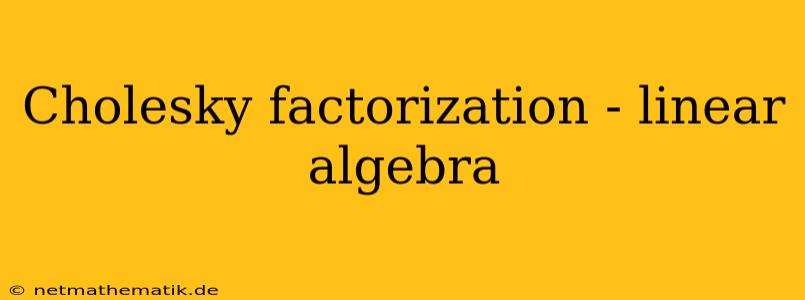Cholesky factorization is a fundamental technique in linear algebra used to decompose a symmetric positive-definite matrix into the product of a lower triangular matrix and its transpose. This factorization plays a vital role in various fields, including numerical analysis, statistics, and engineering, due to its efficiency and stability in solving linear systems, computing inverses, and evaluating determinants.
Understanding Cholesky Factorization
The essence of Cholesky factorization lies in expressing a symmetric positive-definite matrix A as the product of a lower triangular matrix L and its transpose L<sup>T</sup>:
A = LL<sup>T</sup>
Where:
- A is a symmetric positive-definite matrix (i.e., all its eigenvalues are positive).
- L is a lower triangular matrix with positive diagonal elements.
This factorization provides a structured way to represent the original matrix, enabling efficient computation and analysis.
Key Properties of Cholesky Factorization
-
Uniqueness: For a given symmetric positive-definite matrix A, the Cholesky factorization L is unique.
-
Efficiency: The decomposition process involves significantly fewer operations compared to other factorization methods like LU decomposition, making it computationally advantageous.
-
Stability: Cholesky factorization is generally more numerically stable than other methods, particularly for well-conditioned matrices. This stability arises from the positive-definite nature of the matrix, ensuring that the factorization remains well-defined and avoids numerical instabilities.
Applications of Cholesky Factorization
Cholesky factorization finds widespread applications in various domains, including:
1. Solving Linear Systems
One of the most prominent applications of Cholesky factorization is solving systems of linear equations of the form:
Ax = b
Where:
- A is a symmetric positive-definite matrix.
- x is the unknown vector.
- b is the known vector.
The solution process involves the following steps:
- Factorization: Decompose A into LL<sup>T</sup>.
- Forward Substitution: Solve the system Ly = b for the vector y.
- Backward Substitution: Solve the system L<sup>T</sup>x = y for the solution vector x.
This approach offers significant efficiency compared to other methods like Gaussian elimination, especially for large systems.
2. Computing Matrix Inverses
Cholesky factorization provides a convenient method to compute the inverse of a symmetric positive-definite matrix A:
A<sup>-1</sup> = (LL<sup>T</sup>)<sup>-1</sup> = (L<sup>T</sup>)<sup>-1</sup>L<sup>-1</sup>
Since L is lower triangular, its inverse L<sup>-1</sup> is also lower triangular. This property simplifies the computation of the inverse, making it more efficient than direct inversion methods.
3. Evaluating Determinants
The determinant of a symmetric positive-definite matrix A can be efficiently computed using its Cholesky factorization:
det(A) = det(LL<sup>T</sup>) = det(L) det(L<sup>T</sup>) = (det(L))<sup>2</sup>
As L is a lower triangular matrix, its determinant is simply the product of its diagonal elements. This method provides a direct and computationally efficient way to calculate the determinant.
4. Statistical Applications
Cholesky factorization finds numerous applications in statistical modeling and analysis, particularly in:
- Multivariate Normal Distribution: Generating random samples from a multivariate normal distribution, where the covariance matrix is symmetric positive-definite.
- Linear Regression: Estimating the coefficients of linear regression models using maximum likelihood estimation.
- Bayesian Statistics: Implementing Markov chain Monte Carlo (MCMC) methods for parameter estimation in Bayesian models.
5. Engineering Applications
Cholesky factorization proves beneficial in various engineering applications, including:
- Structural Analysis: Solving problems related to structural mechanics, such as stress and strain analysis.
- Finite Element Analysis: Discretizing complex physical systems into smaller elements and solving the resulting linear systems.
- Control Systems: Designing and implementing control algorithms for systems with linear dynamics.
Algorithm for Cholesky Factorization
The Cholesky factorization algorithm can be implemented using the following steps:
-
Initialization: Set L to a zero matrix of the same size as A.
-
Loop over Rows: Iterate through the rows of A from 1 to n, where n is the order of the matrix.
-
Diagonal Element: Compute **L<sub>ii</sub> = sqrt(A<sub>ii</sub> - sum(L<sub>ik</sub><sup>2</sup>) from k = 1 to i-1).
-
Off-Diagonal Elements: For each row j from i+1 to n, compute L<sub>ij</sub> = (A<sub>ij</sub> - sum(L<sub>ik</sub>L<sub>jk</sub>) from k = 1 to i-1) / L<sub>ii</sub>.
-
Output: The resulting lower triangular matrix L represents the Cholesky factorization of A.
Conclusion
Cholesky factorization is a powerful technique in linear algebra that provides efficient and stable solutions for a wide range of problems. Its ability to decompose symmetric positive-definite matrices into triangular forms has made it indispensable in various fields, including numerical analysis, statistics, and engineering. Understanding and utilizing Cholesky factorization opens doors to solving complex computational tasks with greater speed and accuracy. While this article highlights the key aspects of Cholesky factorization, further exploration of its applications and variations can enhance understanding and proficiency in this fundamental tool of linear algebra.
